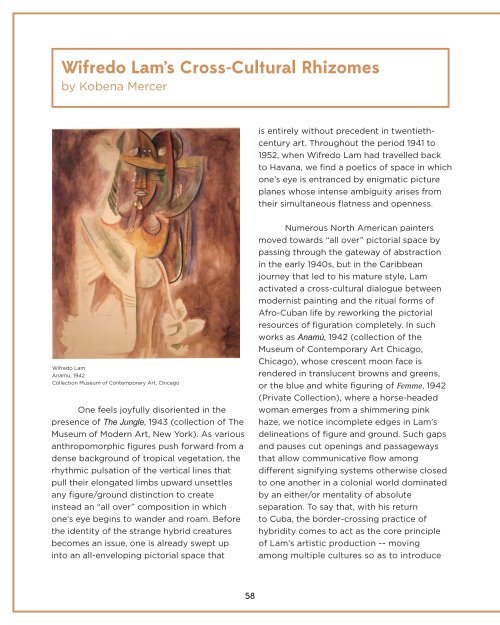Kobena Mercer – Wifredo Lam’s Cross-Cultural Rhizomes
Excerpt from “Lam/Basquiat”, a catalog published by Galerie Gmurzynska on the occasion of a special presentation at Art Basel 2015, prepared in collaboration with Annina Nosei.
Excerpt from “Lam/Basquiat”, a catalog published by Galerie Gmurzynska on the occasion of a special presentation at Art Basel 2015, prepared in collaboration with Annina Nosei.
Create successful ePaper yourself
Turn your PDF publications into a flip-book with our unique Google optimized e-Paper software.
Wifredo <strong>Lam’s</strong> <strong>Cross</strong>-<strong>Cultural</strong> <strong>Rhizomes</strong><br />
by <strong>Kobena</strong> <strong>Mercer</strong><br />
is entirely without precedent in twentiethcentury<br />
art. Throughout the period 1941 to<br />
1952, when Wifredo Lam had travelled back<br />
to Havana, we find a poetics of space in which<br />
one’s eye is entranced by enigmatic picture<br />
planes whose intense ambiguity arises from<br />
their simultaneous flatness and openness.<br />
Wifredo Lam<br />
Anamu, 1942<br />
Collection Museum of Contemporary Art, Chicago<br />
One feels joyfully disoriented in the<br />
presence of The Jungle, 1943 (collection of The<br />
Museum of Modern Art, New York). As various<br />
anthropomorphic figures push forward from a<br />
dense background of tropical vegetation, the<br />
rhythmic pulsation of the vertical lines that<br />
pull their elongated limbs upward unsettles<br />
any figure/ground distinction to create<br />
instead an “all over” composition in which<br />
one’s eye begins to wander and roam. Before<br />
the identity of the strange hybrid creatures<br />
becomes an issue, one is already swept up<br />
into an all-enveloping pictorial space that<br />
Numerous North American painters<br />
moved towards “all over” pictorial space by<br />
passing through the gateway of abstraction<br />
in the early 1940s, but in the Caribbean<br />
journey that led to his mature style, Lam<br />
activated a cross-cultural dialogue between<br />
modernist painting and the ritual forms of<br />
Afro-Cuban life by reworking the pictorial<br />
resources of figuration completely. In such<br />
works as Anamú, 1942 (collection of the<br />
Museum of Contemporary Art Chicago,<br />
Chicago), whose crescent moon face is<br />
rendered in translucent browns and greens,<br />
or the blue and white figuring of Femme, 1942<br />
(Private Collection), where a horse-headed<br />
woman emerges from a shimmering pink<br />
haze, we notice incomplete edges in <strong>Lam’s</strong><br />
delineations of figure and ground. Such gaps<br />
and pauses cut openings and passageways<br />
that allow communicative flow among<br />
different signifying systems otherwise closed<br />
to one another in a colonial world dominated<br />
by an either/or mentality of absolute<br />
separation. To say that, with his return<br />
to Cuba, the border-crossing practice of<br />
hybridity comes to act as the core principle<br />
of <strong>Lam’s</strong> artistic production -- moving<br />
among multiple cultures so as to introduce<br />
58
















